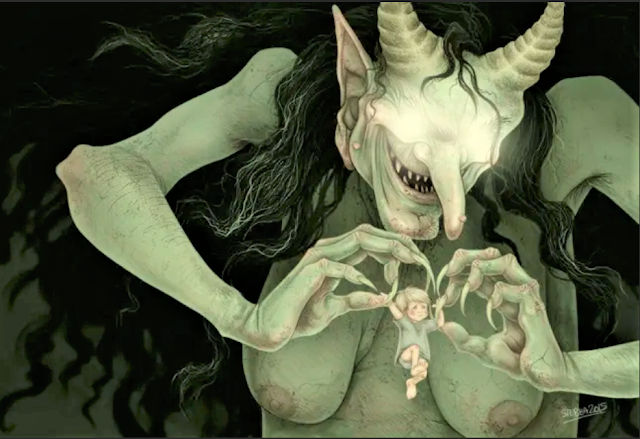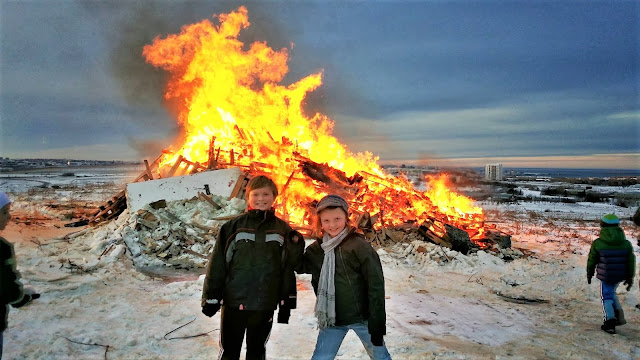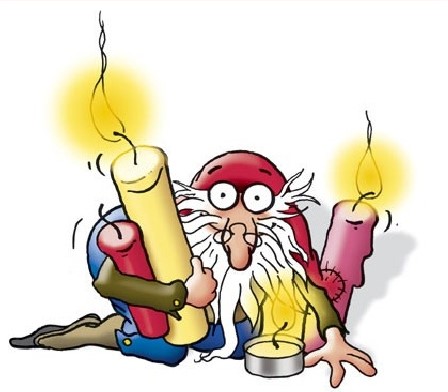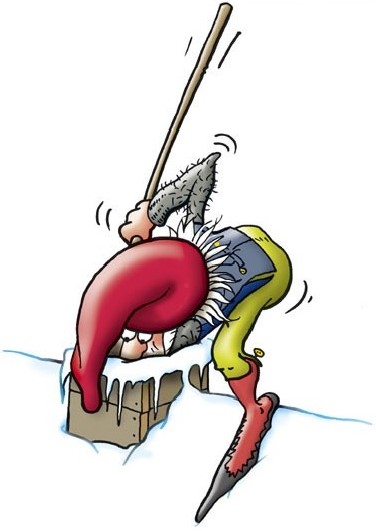Grýla the ogre searches for children in ragged clothing. In fact, children who didn’t get new clothes for Christmas were the most delicious to the taste. Therefore, they were in more danger of ending up in her sack. At Christmas time she is every parent’s threat to a misbehaved child: “If you don’t behave, Grýla is coming to get you and take you away!” She truly is every Icelandic child’s most frightening Christmas story.
Cannibalism

Before Grýla became the human-child-eating ogre as we know her, she lived a cannibalistic life away from humans. Grýla’s first husband was Gustur. He was a boring old fart, so she ate him.
The cannibalistic Grýla couldn’t stand living alone so she married her next husband, Boli. She was very happy with him and had several children together. In fact, rhymes have been made about her sons Leppur, Skreppur, Lápur, Skrápur, Langleggur, Leiðindaskjóða, Völustallur, and Bóla.
However, the sons didn’t make it into the frightening Christmas story. Nevertheless, rumors have it that she grew bored of Boli and ate him too.
Leppalúði
Her third and current husband is Leppalúði. He’s a lazy no good slouch and nothing but mush in his noggin. However, they have been very happy together and produced 20 children, of which 13 of them are the yule lads. If you like to hear who the 13 yule lads are and what they’re our frightening Christmas story.
Infidelity
One day Grýla became so sick that she layed in bed for an entire whole year. Under those circumstances Leppalúði didn’t have the brains to help her. Even more, he was simply too lazy to help her. As a result, he hired a woman by the name of Lúpa to take care of the bedridden Grýla. However, Leppalúði being the pathetic ogre he is, had an affair with Lúpa and got her pregnant.
Lúpa
Lúpa carried the child while taking care of the sick Grýla and gave birth while still under their roof. Lúpa and Leppalúði became the parents of a baby boy that they named Skröggur. When a year had passed, Grýla started feeling better and was able to get out of bed.
To her detriment she saw that her husband had been playing house with the caretaker. As a consequence, she kicked both Lúpa and Skröggur out. This story of infidelity isn’t mentioned in the new versions of our frightening Christmas story, either. In fact, most people don’t know that Grýla was married more than once.
Immortal
In order to make children feel a little better verses and rhymes have been written where both Grýla and Leppalúði died from hunger. This is because the Icelandic children were so well behaved that there was nothing for them to eat. However, these verses also come with the warning that if the children become naughty they will rise from the dead.
Make no mistake, they will come back. As a matter of fact, Grýla has been around for more than 800 years. What’s even more, you can read about her in Íslendinga saga and Sverris saga where she sounds even scarier. However, the sagas versions don’t make it into our modern frightening Christmas story, either.
The sagas
One of the earliest mention of Grýla can be found in the 12th century Sverri’s saga which is one of the King’s sagas. Moreover, she’s also in the more known 13th century Snorra-Edda where she is described as an ogress.

Sverri’s saga is the biography of King Sverre Sigurdsson of Norway (c.1145/1151-1202). When he became the king in 1177, he was the leader of the rebel party, Birkebeiner.
Many people have wondered why the first part of Sverris saga is called Grýla. To tell the truth, there have been several explanations on why but no one really knows. It is a description of Grýla you won’t hear about in the modern frightening Christmas story.

Flateyjarbók - Largest Icelandic medieval manuscript
"People called the first part of the book Grýla because many believed that worry or fear to do with great wars or battles might arise, but that it would then quickly fade away and vanish into thin air, as it reasonable could be expected to in view of the strength and superiority of what was facing."
Rituals and myths have created monsters
There was a time before our frightening Christmas story was written and before Sverrir became the king. This was a time when Sverrir and his Birkebeiner friends lived as outlaws. As outcasts, they were forced to live outside in the heaths and in the woods. As a consequence, their only way to survive was to eat the bark and drink the juice from the trees.
On the other hand, in winter they scraped for the berries which laid frozen underneath the snow. For this reason, many believe that the first part of the book was called Grýla as in The Threat. In fact, life was so rough for them that it was hard to tell whether they were humans or animals.

King Haakon Haakonsson
King Haakon Haakonsson was Sverri's grandson. When Haakon was two years old, the Birkebeiners saved his life by escaping with him through treacherous territory and into Trondheim.

Lillehammer Coat of Arms
It depicts a Birkebeiner skiing in honor of the rescue. The depiction of the Birkebeiners carrying Prince Haakon to safety during the winter of 1206 has become a national icon in Norway.
The prince grew up to be King Haakon IV whose reign marked the end of the period known as the Civil war era in Norway.

Kristin and Haakon
When The 1994 Winter Olympics were held in Lillehammer, there were two mascots: Håkon and Kristin. They were named after king Sverri's two children.
Animalistic

Fending for themselves out in nature brought out the animal within for pure survival. They wore ragged clothing made from skin and bark. Something the modern version of the frightening Christmas story doesn’t tell you is what people thought of Sverrir.
In fact, people compared him to the supernatural being Fingálpn or julebukk who lived up in the mountains and on occasion found his way down to the settlements. Once there, he terrorized the settlers and demanded offerings.

The supernatural monster
The Archbishop, Eysteinn Erlendsson in Österdalen, warned the farmers about Sverrir and his fellow vagabonds coming to take their food supply. So not without surprise, for the common people of the Norwegian settlements Sverrir was a supernatural monster which transformed into a human at will. How is that for a frightening Christmas story?
Ogress

The legends of Grýla extended to the Faroe Islands and Shetland Islands. In Faroe Islands, Grýla comes down from the mountains carrying a large knife and visits the settlements. She is looking for children who whine and cry because they didn’t get meat during Lent.
Whatever happened after Grýla caught the children, was up to each child’s own imagination. This sounds much like the modern frightening Christmas story.

Saksun village - Faroe Islands
A known Grýla verse from Faroe Islands:
Down comes Grýla from the outer fields
with forty tails.
A bag on her back, a knife in her hand,
coming to carve out the stomachs of the children
who cry for meat during Lent.
Many names for one ogress
As Vikings sailed the seas, they picked up a few traditions along the way. One of those places was the island of Foula in Shetland. In fact, they had a version of Grýla as well and called her Skekla (ogress).
This word sounds very similar to the Icelandic word Skessa (ogress). In fact, the name Skekla was used in the northern island of Unst, the Faroe Islands and northern Norway. It simply described a bogey troll-like figure.
The name extended to skekel or jólaskekil/joleskjekel to describe similar supernatural beings. It’s easy to see how Grýla in the modern frightening Christmas story merged from characters from different countries.

Grýla/Skekla verse from Shetland Islands
Skekla (an ogress) rides into the homefield
on a black horse with a white patch on its brow
with fifteen tails
and fifteen children on each tail.
Historical accounts

An account from the Shetland Islands written in 1860, gives the following account of New Year’s guisers:
“In the olden time, on the last night of the old year, five young lads, consisting of a “gentleman”, a “carrying horse” and three others, all disguised, went from house to house, singing what they called a “New’r Even’s Song” and collecting provisions for a banquet on New Year’s Night.
The “gentlemen” wore a cap made of straw with his name lettered on the front, a collar of straw around his neck, a belt of straw around his waist, and a band of straw around his right arm. It was his duty to sing, which he did standing outside the door, and when the song was finished, if invited, he would enter the house, and introduce himself as Vanderdigan come from Drontheim, pronounced Dronton“
The visitor

Robert Menzies Fergusson gave a very fascinating account of his visit to Orkney and Zetland. During his stay he met a fellow tourist who shared with him an experience he had on Halloween a few years earlier.
Frightened beyond compare
“…I saw the kitchen literally full of beings, whose appearance, being so unearthly, shook the gravity of my muscles, and forced the cold sweat to ooze out of every pore in my body. There they stood like as many statues, one of whom was far above the rest, and of gigantic dimensions. Eyes, mouths, or noses had they none; nor the least trace of countenance. They kept up an incessant grunt, grunt, grunt or a noise partly resembling swine or turkey cocks.
The spirits
Their outer garments were as white as snow, and consisted of petticoats below and shirts on the outside, with sleeves and collars. They were all veiled and their head dresses or caps were about eighteen inches in heights, and made of straw twisted and plaited. Each cap terminated in three or four cones of a crescent shape, all pointing backwards and downwards, with bunches or ribbons of every colour raying from the points of the cones.
The spirits for such they appeared to be, had long staves, with which they kept rapping on the floor. Between them and the door stood one as black as ´Horni ;´but more resembling a human being than any of the others. His head dress was a South-wester, and he had a keshie [a bag made of straw] on his back. My landlady by this time had considerably recovered and the sight of the keshie tended greatly to allay our doubts, and we all ventured into her kitchen.
The Keshi
“Immediately upon entering the kitchen they formed themselves in pairs and commenced hobbling and dancing. When asked what they wanted the keshie was presented; and in it was a piece of mutton and other eatables. Their chieftain, or leader, muttered in a disguised and guttural tone of voice, that they would take anything we chose to give them.
My landlady gave them some mutton and oatcakes, with which they appeared highly elated and returned thanks with bows and curtseys: but still kept up the incessant grunting. Before leaving the house, however, they inquired of me, in the same guttural tone of voice, if they should go to the Minister’s. “Certainy,” said I: “be sure you go there, and give him a specimen of your dancing: for the minister is a very liberal gentleman and will, I doubt not, fill your keshi.
Far north
“Such is a description of what was common enough some thirty years ago in the Far North. When a band of guizards have had a fair night’s work they generally assemble at some rendezvous, where all the good things are disposed of in a festive manner. The leader of the gang is known by the name of “Scuddler” while the one with satanic appearance is called Judas.” Rambles in the far north by R. Menzies Fergusson
Rituals
The ritualistic history of Grýla as we know her in the modern frightening Christmas story has an even deeper background. Her origin can also be traced back to Scandinavian dance rituals like vikivaki and julebukk. Originally, julebukk was a game played in the livingroom (julestuen) between Christmas (jul) and New Year (romjulen).
Goat heads
Everyone, regardless of social standing was invited to join the festivities. People celebrated all day and all night. There was lots of drinking and playing games. However, the main event was a young man dressed up as a goat. He would enter the living space with a goat’s head on a stick and clad in its coat. He would often have a wooden hammer to resemble Thor’s Hammer, which depicts where the heathen tradition originated.
Julebukk
The julebukk had one main purpose which was to scare both children and adults. The julebukk beast wanted to know who had been good and who had been naughty the past year. It would jump and dance while the rest of the guests sang and joined in. Then it dropped down dead, just like Thor’s ram. As the song continued, the ram came back to life.
In some of the julebukk traditions, the person wearing the goat costume disguises his voice and goes door to door. The goal is for people to figure out who is wearing the costume. The person in the costume stays until the guests can figure out who’s behind the mask. Usually they wear the disguise to get treats. In some traditions they sing songs.
Strawman

Costume traditions in Faroe Islands and the Shetland Islands are female monsters clad in tattered animal skins, straw or seaweed. They visit farms and villages and demand offerings. The Faroe Islands had this custom as well but they referred to the offerings as grýlubita. The Faroese grýlur usually appear on grýlu eve (grýlukvöld), which happens to be the first Tuesday in Lent.
The Svabo’s Dictionarium færoense, describes the word grujla as a person wearing a costume or a bogeyman used to frighten children at Lent: a costumed figure. Another word similar to grujla is grȗiliur and means abominable. The description of such a beast is one who has a large coat of seaweed dragging behind her like a tail. In addition, she has a rusty black hook in each hand and a big bag made of skin on her back.
Grýla costumes
In Shetland, long before there ever was an Up-Helly Aa festival in Lerwick, Shetland Islands, there was an older ritualistic tradition where people dressed up in decorative straw suits and hats. Disguised in these costumes, they went from door to door.
On the island of Unst, these dressed-up people were known as gröleks. The word grölek is just another way to say grýla. This becomes more apparent when you look at the various spellings that exists of the word: gröli, grölik, grulek, gruli, grulick, grulja, grulik and grillock.
Skekling

The wedding ceremony
The Art Rambles in Shetland describes the wedding ceremony as such:
“About nine o’clock, commotion and whispering being observed amongst those nearest the door, the fiddler stops, dancing ceases and the “honest man” informs the company that the “guisers” have arrived.
The scuddler
On the best man announcing that there is plenty of both meat and drink for all comers – five gallons of whisky it may be yet untouched – the fiddler is told to “play up the guiser’s spring” when in walks a tall slender-looking man, called the “scuddler”, his face closely veiled with a white cambic napkin, and on his head a cap made of straw, in shape like a sugar-loaf, with three loops at the upper extremity, filled with ribbons of every conceivable hue, and hanging down so as to cover the cap.
He wears a white shirt with a band of ribbons around each arm and a bunch of ribbons on each shoulder, with a petticoat of long cleans straw, called “gloy” which hangs loosely. The moment he neters he gives a snore and having danced for a few minutes, another enters, called the “gentleman”, somewhat similarly attired: he too, having danced, a third, called the “fool” appears and so till all are in.
The guisers
And it is really a strange sight to see six tall young men dressed thus fantastically, and dancing with so much earnestness. They are careful to speak not a word lest they reveal their identity: and not a sound is heard but the music of the fiddle, the rustle of the straw petticoats, the thud of their feet on the earthen floor, the laughter of the “fool” and the whispers of the bride’s maidens guessing who the guisers may be.”
Monster at the door

Just like the other grýla variations, the Shetland gröleks and the skeklers, didn’t use their normal voices when they knocked on doors. A part of the custom was to disguise the voice so nobody could recognized them. Instead, they made animal-like grunting noises and and spoke while inhaling. When invited inside, the skekler gathered everyone around the fire and danced.

"Trick or Treat"
It is also noteworthy that, like the Faroese grýlur and mainland Scandinavian julebukker, the gröleks and the skeklers used to demand some form of offering when they made their visits, most particularly meat. They gave nothing in return.

Finngálkn
Finngálkn (which is what the julebukk was considered to be) is a mythical creature you hear about in many ancient sagas. They move around like a chimera and are usually a mix between human and animal. þingálp(n) is connected to or derived from Finngálkn.
The word skekler is very similar to the Old Icelandic word skekill, which means the “shanks or legs of an animal’s skin when stretched out”
Grýla

Grýla was similar to the Svínoy’s Grylen, and the supernatural Faroese Grýla which is describes as having a goat’s body, but walking upright like a man. She looks like a julebukk and not like a woman.

Julebukk
The Shetland word grölek originates from the word grökle which is related to the julebukk in Kviteseid, Norway. Similarly, the word skekler relates to the Norwegian word kveldsjögl/kveldsgjögla. This word was synonymous to julebukk figures in Nissedal and Vest Agder. They also used the word skulkar for party gate-crasher.
Pagan ritual masks
Two masks were found onboard the ship at the harbor in Hedeby. They were used for the caulking of a hull.
The mask presented in the photo, has been made of red felt. It is uncertain what species of mammal it depicts. It could possibly be a dog, sheep or even a fox. In addition, there has also been some discussion of what it was used for. There are those who believe the masks were used as props at the theater. However, others believe it was used in rituals or as a disguise.
Could it be the mask of a berserker or ulfhéðnar?
Sources:
The ‘intriguing and unsettling’ Scottish island tradition of skekling English
Skeklers. Document Scotland English
Anna McCully Stewart – Knock Knock Who’s There.pdf (skemman.is) English
Saga Conference English
Julebukken kommer! – Serieliv Norwegian
Animal figures and Cross Dressing in the Icelandic Vikivaki Games English
The Giant Sword and the Candle English
Hedeby masks English
The folk-stories of Iceland English
Grýla and Leppalúði Icelandic














